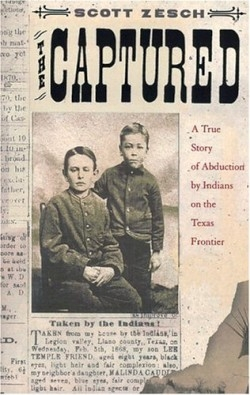The Captured
A True Story of Abduction by Indians on the Texas Frontier
On New Year’s Day 1870, a German settler in Texas Hill Country, Johanna Korn, watched as her ten-year-old twins, Charlie and Adolph, left their cabin to herd sheep for a neighbor. When she casually told Adolph good-bye, she couldn’t have imagined it would be for three years. Or that when he returned, her son would be a stranger who despised everything she stood for.
Adolph, stolen by three Apaches that day, is eventually adopted by the Comanches. He becomes what anthropologists term a “White Indian.” He is also the author’s distant relative, a half-brother of Zesch’s grandmother’s grandmother.
This is a ten-disc audio version of his recently published book, in which he tells how his interest in the topic is piqued when he discovers Korn’s barely marked gravesite in a local cemetery. As he traces the history of the conflict between these German-American immigrants and the Southern Plains Indians, Zesch also follows the lives of eight other youngsters captured during this same period.
The author, a sixth-generation Texan and writer of the historical novel, Alamo Heights, divides his time between New York City and his Texas roots. The narrator, a nationally recognized voice-over artist, reads the text in a way that is dead-on perfect for this historical and personal tale.
Zesch’s descriptions of the cruelties committed by both the whites and the Indians are unapologetically matter-of-fact. Brother and sister Dot and Banc Babb witness the murder and scalping of their mother, Isabel, when they are abducted in the fall of 1866. The brutal aftermath of the February 1868 raid on the home of the Friend family in Legion Valley is also depicted.
The lives of the “White Indians” after their initial capture, and their families’ efforts to retrieve them, are varied, but readers are rewarded by Zesch’s extensive research. He discovers that his Uncle Adolph, who went on raids with the Comanches, was known as “Cachoco,” which translates into “Not an Old Man.”
The “Stockholm Syndrome” is one possible explanation for the quick assimilation of the children into the Indian culture. “By the spring of 1871, Rudolph Fischer and Temple Friend were already full-fledged Comanches. Korn, Herman Lehmann, and the Smith brothers had all passed the initial trial by fire. These timid farm boys were well on their way to becoming juvenile Indian warriors.”
Their passage back into the white world wasn’t quite as easy, as detailed in a chapter titled “In the Limelight.” For example, Zesch’s ancestor chose to live out his final days alone in a cave. Lovers of history will enjoy this slice of America intertwined with the author’s own family story, which comes full circle when “Uncle Adolph finally got a proper headstone in 2000, a century after he died.”
Disclosure: This article is not an endorsement, but a review. The publisher of this book provided free copies of the book to have their book reviewed by a professional reviewer. No fee was paid by the publisher for this review. Foreword Reviews only recommends books that we love. Foreword Magazine, Inc. is disclosing this in accordance with the Federal Trade Commission’s 16 CFR, Part 255.

